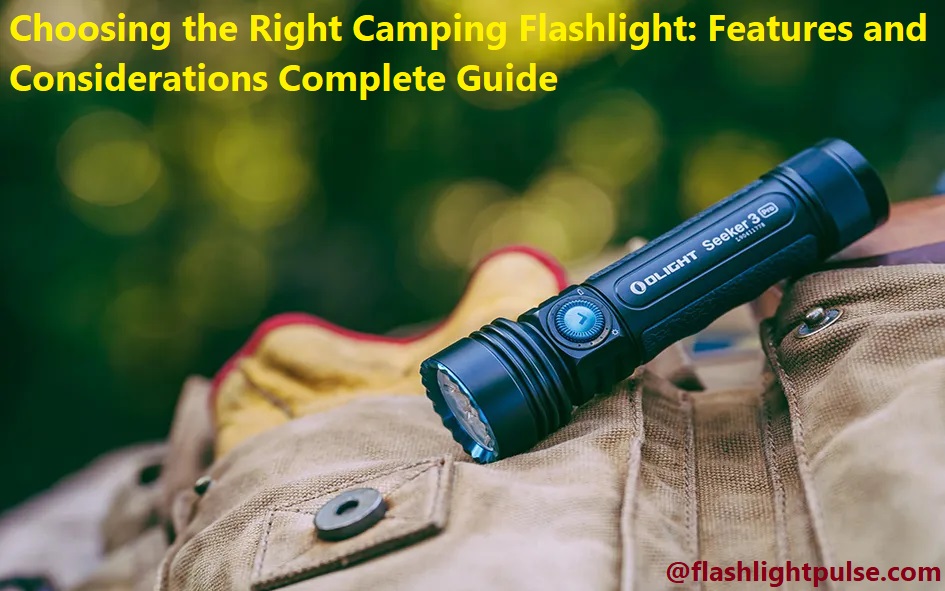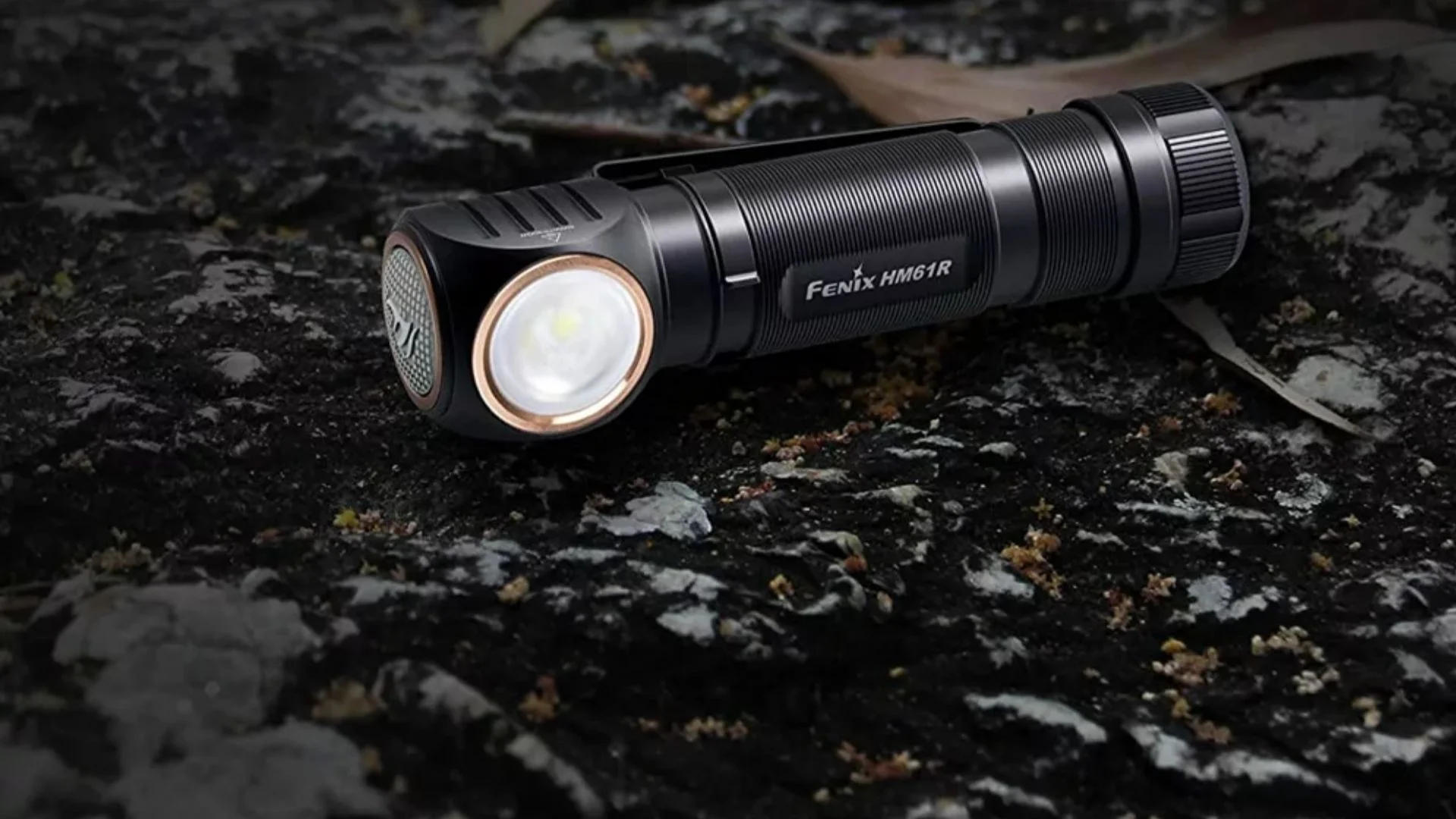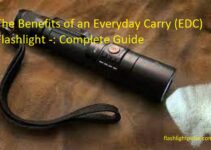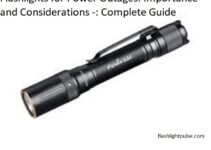Are you ready for a night of outdoor camping? A crucial part of your gear is a reliable flashlight to get around in the dark. Having the right camping flashlight can make or break your night. You’ll want one that suits your needs, so let’s explore features and considerations to find the perfect one for you!
Camping and outdoor activities require the right tools, especially when it comes to illumination. Whether you’re hiking, mountain biking, fishing or just star-gazing, having a quality flashlight is essential.
Flashlights come in all shapes and sizes, and each has their own unique features and advantages. When selecting the right light for your needs, some important factors to consider include brightness level, beam angle, batteries or recharging options as well as ruggedness for outdoor use.
This guide will provide you with an overview of the most important features of a camping flashlight – from basics such as bulb technology to specific uses such as search lights – in order to help you decide which one is best for your next outdoor adventure.

Explanation of the topic
Exploring the great outdoors can be an exciting adventure filled with wonderful discoveries. Equally important is choosing the right camping equipment, particularly when it comes to picking out a reliable flashlight for your trip. With so many different types of flashlights on the market, selecting one that meets your individual needs is not always easy. It’s important to consider factors such as size, battery life, and whether or not you need additional features like waterproofing and red LEDs.
This comprehensive guide will explain the features and considerations to take into account when selecting a camping flashlight. We’ll go over the differences between common flashlight designs and why you might choose one type over another. Additionally, we’ll provide our top picks so that you can make an informed choice with confidence!
Importance of choosing the right camping flashlight
Choosing the right camping flashlight is an important task, especially if you plan to use it in a camping or off-grid situation. The wrong flashlight can cause accidents or put you and your companions in an unsafe position. Not only that, but if your flashlight runs out of power while in a dangerous place you may be unable to complete your task or even find your way out. This is why it is important to purchase a reliable, durable and long-lasting product for rugged outdoor activities such as camping.
When choosing the right camping flashlight for your needs, there are several features and considerations that need to taken into account such as battery life and brightness level. Battery life will determine how long the light will last before needing recharging or new batteries inserted. Brightness level will determine how much light is emitted from the flashlight which can be used for specific tasks like illuminating paths during night hikes. Furthermore, depending on the size of the space being lit up, a more powerful light may be needed to get ample illumination throughout. Additionally, make sure to pay attention to what type of batteries are used by the flashlight model; rechargeable models with USB cords are ideal so they can be easily charged while on outings. Finally, look at what materials the exterior was made with so you know it is waterproof and suitable for any outdoor activity it may be subjected to during use. Taking all these features into consideration will ensure that you make an informed decision when choosing both a safe and practical item for all of your camping needs!
Overview of the guide
This guide will provide an overview of the key features, considerations, and recommendations for choosing the right camping flashlight. By following this guide, you will be able to choose a camping flashlight that meets all your needs, whether you are a casual hiker or an experienced backcountry explorer.
The guide will cover everything from considering size, weight and battery life to understanding runtime and brightness settings. In addition, we’ll look at special features like additional lighting modes for different uses and discuss some helpful tips on how to maintain your flashlight once you have it.
Finally, we’ll review our top picks for camping flashlights of various levels so that you can choose one that fits your specific needs. By understanding the features available in today’s market of flashlights and considering your own specific requirements, you can make sure you end up with the best camping flashlight possible.
Factors to Consider When Choosing a Camping Flashlight
When choosing a camping flashlight, there are a few important factors to consider. Here is a list of factors to take into account when making your selection:
- Brightness: The lumens rating of the flashlight will tell you how bright it will be. Generally, higher lumens means brighter, but this also depends on battery life and size of the bulb.
- Beam range: This is how far the beam from the flashlight can reach in perfect conditions. This will depend on reflectors and types of lens in the headlamp and may be measured in meters or feet. Generally, wider beams will reach further than narrow ones for shorter distances.
- Battery life: This determines how long the light can stay on before needing to be recharged or changed for another set of batteries, which is usually dependent on battery type and capacity as well as beam brightness settings.
- Ease of use: This refers to how easy it is to operate your camping flashlight while in dark conditions including switches, access buttons or controls when operating with gloved hands or while wearing headlamps at night time etc
- Durability: A crucial factor when choosing any piece of outdoor equipment is its durability — after all you are planning on taking it outdoors! Look for quality materials such as aluminum or steel, shock-resistant technology like rubber mounting grips and waterproofing features such as O-rings or water-resistant seals — these features ensure your camping flashlight won’t let you down in less-than-ideal camping conditions!
- Weight/bulkiness: As with most outdoor gear, weight and bulkiness count — depending on your activity outdoors you may want a more lightweight/compact design that fits comfortably in your pocket over one that takes up space in larger packs. Consider what type of terrain you plan on tackling when making this decision since some sturdier models may serve better than smaller one if used for rougher adventures outdoors!
- Brightness
When it comes to camping, having a good flashlight is essential for safety and convenience. From late-night treks to the outhouse to searching for small items around the campground, a powerful flashlight will come in handy in a variety of situations. With so many flashlights on the market, it can be difficult to choose the best one for your needs. This guide will provide guidance on how to select the right camping flashlight by incorporating features and considerations such as brightness, battery options, beam distance and more.
Brightness is one of the most important features when selecting a camping flashlight. When shopping for a new light, look for lumens, which measure the total amount of light that flashes from your light source are measured in lumens and not watts like traditional lights. The higher the number of lumens that a flashlight emits, the brighter it will be—providing enough power and accuracy of sight that you need outdoors at night. Along with this, consider runtime—how long you can use your flashlight until it loses power–which can range from 1-20-hours depending on how bright you are running your device.
Battery Life
When it comes to choosing a camping flashlight, battery life is an important factor to consider. A longer battery life will ensure that you have enough light to get you through your camping trip. Most camping flashlights are powered either by disposable or rechargeable batteries.
Disposable batteries- While single-use disposable batteries can work well for shorter trips, they tend to lack the power or capacity of multiple or larger-sized rechargeable lithium-ion batteries, and can suddenly run out of power and leave you in the dark when least expected.
Rechargeable batteries – Rechargeables come in two varieties: Lithium-Ion (Li-Ion) and Nickel Metal Hydride (NiMH). While Li-Ion batteries tend to offer higher energy capacities than NiMH, they also typically cost more and require dedicated chargers that may be hard to find if you don’t already own one. NiMH rechargeables are less expensive than Li-Ion, but can often take longer to charge up fully.
To determine battery life, look for a flashlight that has a published run time (or average amount of time before needing another charge), as well as a lumen rating (which will tell you how bright it gets). Also consider whether any external power sources may be available to use in case your primary power source runs out during the trip.

Durability
When choosing a camping flashlight, it is important to consider the durability of the item. The flashlight should be able to withstand being dropped or accidentally submerged in water or outdoors humidity. Many camping flashlights are designed with rubberized exterior and feature waterproof seals that make them resistant to weather elements and dust.
It is also important to choose a flashlight with an LED bulb, which has a longer lifespan than most traditional incandescent bulbs, so you don’t need to worry about replacing bulbs on a regular basis. Higher end models may also offer replaceable battery packs or rechargeable lithium-ion batteries, so you don’t have to worry about the light going out in harsh weather conditions. Furthermore, some models are shockproof for additional durability and can take a few knocks without damage without compromising the performance of the light itself.
Size and Weight
When choosing a camping flashlight, size and weight are key factors to consider. Most flashlights are made with a large body and a smaller head. The body contains the power source — usually either batteries or rechargeable lithium batteries — and the head contains the LED lightbulb. A larger body will offer longer power, while a smaller body offers increased portability. In general, battery-powered flashlights tend to be lighter than those that use rechargeable batteries, though this can vary depending on the type and quality of batteries used in your flashlight.
You may also want to consider how easy your chosen camping flashlight is to handle and grip. Features like straps or finger loops can provide additional comfort amid variation in sizes, shapes and weight of different models. Additionally, when you’re considering size for travel purposes, make sure you know its dimension when packed away so it will fit into your bag or pocket easily should you need it on-the-go!
Water Resistance
Having a flashlight that is resistant to water damage is essential when selecting the right camping flashlight. Look for flashlights that are labeled as waterproof, or at least water resistant with an IPX rating. IPX ratings measure the degree of protection against solid objects and liquids, with a number between 0-8, 8 being the highest level of protection.
Keep in mind that water-resistant flashlights may not be able to be immersed in water for long periods of time or submerge them too deep. Additionally, these flashlights are usually cleared for rain and snow but not meant for swimming or river rafting. More extreme cases can include models specially designed for diving purposes further emphasizing how important it is to read labels carefully or contact customer service if needed.
Additional Features to Look for in a Camping Flashlight
When you’re shopping for a camping flashlight, you should also consider some of the additional features that can help enhance your lighting experience. Below is a list of features and considerations that can help guide your purchasing decision.
Brightness Control: Look for flashlights that offer multiple brightness levels that allow you to customize its beam intensity for specific tasks like nighttime navigation or reading.
Weatherproofing: Look for flashlights with a waterproof rating such as IPX7 (waterproof up to 1 meter underwater). This will ensure reliable performance over a range of wet conditions like rain or snow.
Size & Weight: Consider the size and weight of the flashlight in relation to its total capacity and output level, as well as how easy it is to carry in your pocket or bag.
Battery Types & Durability: Flashlights come with different battery types like AAA, AA, or rechargeable lithium ion batteries. Be sure to check how many hours of continuous use each type allows before throwing out old batteries.
Rechargeable Capability: Choosing a rechargeable flashlight can save you money on replacement batteries since they require fewer replacements throughout the life of your light source. Many flashlights offer an internal charging feature via USB cable so make sure to check this before purchase!
Adjustable Beam
A flashlight with adjustable beam allows you to change the width or angle of the light beam that is emitted. This makes for a more versatile lighting experience. You may choose a flood or spot beam setting to match the type of outdoor activity in which you are engaged.
If you plan on camping, fishing or hiking in dark areas, having the ability to adjust your light beam will allow you to focus on whatever task is at hand. Additionally, some flashlights have an adjustable brightness setting which allows for further customization and versatility in lighting conditions.
It is important to consider what features are most important for your intended use and then select a flashlight model that best meets your needs.
Red Light Mode
The red light or night vision mode is a great feature for camping flashlights. As the name implies, this flashlight uses a dim red LED bulb to provide soft illumination without hurting user’s night vision. This can be particularly helpful when you’re fishing, observing wildlife, setting up a tent, searching for items in the dark, or navigating in low light conditions.
One thing to keep in mind is that different flashlights have different levels of intensity when it comes to the red light mode. Some models have enough output to perform basic tasks such as reading and walking around safely while others have enough power to ward off an intruder. Be sure to understand the output levels before you buy so you know what sort of illumination power you can expect from your torch.
In addition, some flashlights feature multiple intensities in their red-light mode. This allows the user to adjust the beam from a low level of brightness for reading and general navigation up to cloudburst illuminator for maximum visibility — even in total darkness. If this is something that interests you, then make sure you check out models with multiple settings or programmable settings if that’s an option with your model!

Conclusion
Choosing the right camping flashlight doesn’t have to be a complicated task. When considering what type of flashlight will best fit your needs, think about the features that matter most to you, such as light output, battery type and size.
Other features, such as waterproofing and portability should also be taken into account when making your decision. By understanding the features that are available in today’s flashlights and by understanding your own specific needs, you can make an informed decision on which type of camping flashlight is right for you.
With a reliable flashlight in hand, campers of all ages will have added peace of mind during their next outdoor adventure.
FAQs
How do I choose a camping flashlight?
Consider factors like size, weight, battery life, durability, brightness, and special features like waterproofing or a red light mode.
What should I look for in a good flashlight?
A good flashlight should have a high-quality LED bulb, durable construction, long battery life, and multiple brightness settings. Waterproofing, a strobe mode, and a red light mode can also be useful features.
How many lumens is a good flashlight for camping?
A good flashlight for camping should have at least 200-300 lumens. This is bright enough to light up your campsite and navigate in the dark.
What are the specifications of a flashlight?
Flashlight specifications can include lumens, beam distance, battery type, runtime, and special features like waterproofing or a red light mode.
Why is a flashlight important in camping?
A flashlight is important in camping because it provides light for navigation, setting up camp, cooking, and safety. It can also be used for signaling for help in an emergency.
How many lumens is enough for a flashlight?
The number of lumens needed in a flashlight depends on its intended use. For general camping use, a flashlight with at least 200-300 lumens should be sufficient.
What kind of light do you use for camping?
A flashlight or headlamp with a white LED light is typically used for camping. Some campers also prefer red light for preserving night vision.
What color flashlight is best for night?
Red light is best for night use because it preserves night vision and doesn’t attract bugs as much as white light. However, a white light can be useful for lighting up a larger area.
How many watts does a flashlight need?
The wattage of a flashlight doesn’t necessarily determine its brightness. Lumens is a more accurate measurement of brightness.
How do I choose a headlamp for camping?
When choosing a headlamp for camping, consider factors like weight, battery life, brightness, waterproofing, and special features like a red light mode or adjustable beam angle.
See More :
- Best 18650 for flashlight 2023
- Best aa flashlight 2023
- Best camping flashlight 2023
- Best edc flashlight 2023
- Best flashlight for emergencies 2023


